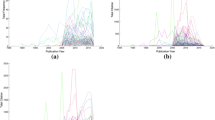Abstract
During the last decade, several scientometrics as well as bibliometrics indices were proposed to quantify the scientific impact of individual. The h-index gives a breakthrough in scientific evaluation, but this index suffers with big hit problem, i.e., once a paper is selected in h-core publication, further citation of h-core articles is not considered in scientific evaluation. To overcome this limitation of h-index, the e-index was proposed, but it does not consider the core citation count. It considers only the excess citation count. To overcome this limitation, the EM-index is proposed in this article. The EM-index is the extension of h-index and e-index, which uses the concept of multidimensional h-index. The EM-index uses all citation counts of h-core articles at multi-level to quantify the scientific impact of the individual. But this index does not consider all publication citations. To overcome this limitation of EM-index a multidimensional extension of the EM-index is also proposed called EM′-index. To validate the proposed indicators, an experimental analysis has been done on 82 scientist’s publication citation count, who are working in scientiometrics field. In such a way, we found a more balanced and fine-grained approach to evaluate the scientific impact of individual as well as to compare the scientific impact of two different researchers/scientists.





Similar content being viewed by others
Change history
26 July 2018
In the original publication, Acknowledgements was published with incomplete information. The complete Acknowledgements is given in this correction.
References
Alonso, S., Cabrerizo, F. J., Herrera-Viedma, E., & Herrera, F. (2009). h-index: A review focused in its variants, computation and standardization for different scientific fields. Journal of Informetrics, 3(4), 273–289.
Bornmann, L., & Daniel, H.-D. (2007a). Convergent validation of peer review decisions using the h index: Extent of and reasons for type i and type ii errors. Journal of Informetrics, 1(3), 204–213.
Bornmann, L., & Daniel, H.-D. (2007b). What do we know about the h index? Journal of the American Society for Information Science and Technology, 58(9), 1381–1385.
Costas, R., & Bordons, M. (2007). The h-index: Advantages, limitations and its relation with other bibliometric indicators at the micro level. Journal of Informetrics, 1(3), 193–203.
Dorta-González, P., & Dorta-González, M.-I. (2011). Central indexes to the citation distribution: A complement to the h-index. Scientometrics, 88(3), 729–745.
Egghe, L. (2006a). An improvement of the h-index: The g-index. ISSI Newsletter, 2(1), 8–9.
Egghe, L. (2006b). Theory and practise of the g-index. Scientometrics, 69(1), 131–152.
Egghe, L. (2007). Dynamic h-index: The hirsch index in function of time. Journal of the American Society for Information Science and Technology, 58(3), 452–454.
García-Pérez, M. (2009). A multidimensional extension to Hirsch’s h-index. Scientometrics, 81(3), 779–785.
García-Pérez, M. A. (2012). An extension of the h index that covers the tail and the top of the citation curve and allows ranking researchers with similar h. Journal of Informetrics, 6(4), 689–699.
Hirsch, J. E. (2005). An index to quantify an individual’s scientific research output. In Proceedings of the National academy of Sciences of the United States of America, pp. 16569–16572.
Jin, B. (2006). H-index: An evaluation indicator proposed by scientist. Science Focus, 1(1), 8–9.
Jin, B. (2007). The AR-index: Complementing the h-index. ISSI Newsletter, 3(1), 6.
Jin, B., Liang, L., Rousseau, R., & Egghe, L. (2007). The R-and AR-indices: Complementing the h-index. Chinese Science Bulletin, 52(6), 855–863.
Maabreh, M., & Alsmadi, I. M. (2012). A survey of impact and citation indices: Limitations and issues. International Journal of Advanced Science and Technology, 40, 35–53.
Martin, B. R. (1996). The use of multiple indicators in the assessment of basic research. Scientometrics, 36(3), 343–362.
Prathap, G. (2010). Is there a place for a mock h-index? Scientometrics, 84(1), 153–165.
Rosenberg, M. S. (2014). A biologist’s guide to impact factors. Technical report, PeerJ PrePrints.
Rousseau, R., & Ye, F. Y. (2008). A proposal for a dynamic h-type index. Journal of the American Society for Information Science and Technology, 59(11), 1853–1855.
Schreiber, M. (2008). A modification of the h-index: The hm-index accounts for multi-authored manuscripts. Journal of Informetrics, 2(3), 211–216.
Schubert, A. (2011). A Hirsch-type index of co-author partnership ability. Scientometrics, 91(1), 303–308.
Todeschini, R. (2011). The j-index: A new bibliometric index and multivariate comparisons between other common indices. Scientometrics, 87(3), 621–639.
Todeschini, R., & Baccini, A. (2016). Handbook of bibliometric indicators: Quantitative tools for studying and evaluating research. London: Wiley.
Van Leeuwen, T. N., Visser, M. S., Moed, H. F., Nederhof, T. J., & Van Raan, A. F. (2003). The holy grail of science policy: Exploring and combining bibliometric tools in search of scientific excellence. Scientometrics, 57(2), 257–280.
Vanclay, J. K. (2007). On the robustness of the h-index. Journal of the American Society for Information Science and Technology, 58(10), 1547–1550.
Zhang, C.-T. (2009). The e-index, complementing the h-index for excess citations. PLoS One, 4(5), e5429.
Acknowledgements
The authors wish to express their gratitude to anonymous reviewers for their helpful comments. The authors thank to Dr. Miguel A. García-Pérez for providing Matlab code for two-sided h-index. This helped us to design an algorithm for the EM-index.
Author information
Authors and Affiliations
Corresponding author
Rights and permissions
About this article
Cite this article
Bihari, A., Tripathi, S. EM-index: a new measure to evaluate the scientific impact of scientists. Scientometrics 112, 659–677 (2017). https://doi.org/10.1007/s11192-017-2379-x
Received:
Published:
Issue Date:
DOI: https://doi.org/10.1007/s11192-017-2379-x




